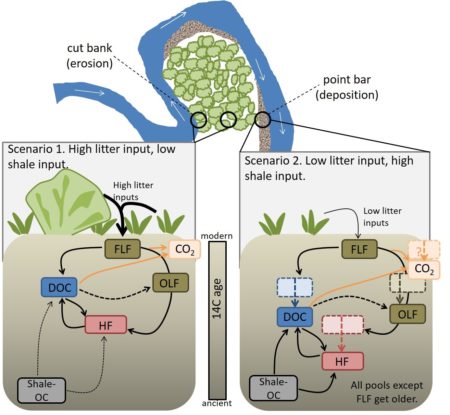
Conceptual diagram showing two scenarios: (1) high litter input with low shale input, and (2) low litter input with high shale input. Scenario 1 is emblematic of regions of the floodplain with more extensive soil development (e.g., cut bank and middle of the meander) and non-shale systems, where OC is derived primarily from plant detritus and the 14C age is controlled by occlusion of litter fragments in aggregates (OLF), which physically protects it from degradation, and mineral protection of processed OC (e.g., partially oxidized and degraded) through adsorption or occlusion within mineral particles (HF). Scenario 2 (point bar) represents a shale-rich environment with low litter inputs, where the OC is derived from both shale and plant litter and 14C age of all pools except for FLF is lowered by the presence of shale-derived carbon. The role of shale-derived OC in CO2 release is currently unknown.
Shales contain high levels of organic carbon (OC) and represent a large fraction of the earth’s carbon stocks. Recent evidence suggests that shale-derived OC may contribute to the carbon cycle in some riverine systems, however this process is poorly understood and not currently considered in global C models. Through detailed sediment analysis coupled with radiocarbon measurements, and synchrotron carbon spectroscopy, this study determined the abundance, chemistry, and mobility of shale-derived OC in floodplain sediments of a shale-rich mountainous watershed.
Radiocarbon measurements reveal that 23-34% of OC in East River floodplain sediments is derived from shale, including types of sediment-OC which are considered to be relatively mobile and available for use by microbes. While the contribution of shale-derived OC to CO2 production and export is currently unknown in this system, the observation of shale-derived OC in carbon pools which is actively cycling suggests that this topic warrants further research. The results demonstrate the importance of shale weathering in the floodplain, particularly under low plant-litter environments, with implications for the global carbon budget and other shale-associated elements, including growth-limiting nutrients (e.g., N) and toxic elements (e.g., As, Se, U).
Summary
Shales contain high levels of organic carbon (OC) and represent a large fraction of the earth’s total carbon stocks. While recent evidence suggests that shale-derived OC, which is millions of years old, may be actively cycled in riverine systems, this process is poorly understood and not currently considered in global C models. In this study, the authors analyze sediments collected from the floodplain of the East River, Colorado, located in a high-elevation mountainous watershed underlain by shale bedrock, to determine the importance and mobility of shale-derived OC in this environment. OC closely associated with sediment minerals is the largest (84 ± 6%) and oldest OC pool, containing a large, but variable, amount of shale-derived OC. Evidence of shale-derived OC is also observed in other sediment OC pools which are considered to be more mobile and more easily degraded to carbon dioxide by bacteria (e.g., water-soluble). Carbon spectroscopy revealed that floodplain sediments had a higher degree of functionalized aromatic groups and lower carbonate content compared to shale collected nearby, consistent with chemical alteration and mixing with other C sources in the floodplain. This study concludes that there are two primary OC sources in floodplain sediments, plant-litter and shale-derived OC, each with distinct chemical characteristics and reactivity. The authors estimate 23-34% of the sediment OC is derived from shale, demonstrating the important contribution of shale-OC to the carbon cycle at this site, particularly in environments with low plant-litter inputs.
Citation
Fox, P. M., Bill, M., Heckman, K., Conrad, M., Anderson, C., Keiluweit, M., and Nico, P. S. “Shale as a Source of Organic Carbon in Floodplain Sediments of a Mountainous Watershed.” Journal of Geophysical Research: Biogeosciences, 125, (2020). DOI: 10.1029/2019JG005419
